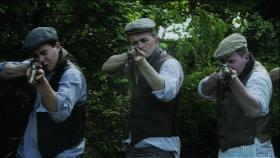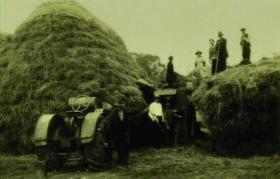Fear and loathing at Coolacrease
Published in 20th-century / Contemporary History, Issue 1 (Jan/Feb 2008), News, Revolutionary Period 1912-23, Volume 16
Dramatic reconstruction of the IRA firing squad at Coolacrease. The medical records do not support the programme’s contention that there was sexual mutilation involved—i.e. that the Pearsons were deliberately shot in the genitals and the buttocks—but suggest rather that this was a botched execution carried out by inexperienced volunteers. (RTÉ Stills Library)
November’s Hidden History documentary on the killing of the Pearson brothers, Richard and Abraham, at Coolacrease, Co. Offaly, in June 1921 struck a raw nerve. The subsequent comment in the press, radio and on the web generated more heat than light and highlighted the extent to which comment about the War of Independence period is still driven by present-day ideological concerns. The fact that the Pearsons were Protestant ‘strong farmers’ and members of the evangelical Cooneyite sect added extra weight to charges that the killings were carried out for sectarian and/or land-grabbing motives, and this was inferred throughout the documentary. The evidence, however, suggests that the Pearsons were killed because they had previously fired on IRA volunteers (seriously wounding one) who were cutting down trees on Pearson land for the purpose of mounting a roadblock. Should we be surprised that the IRA responded to an attack on its volunteers by punishing those responsible (as it did elsewhere)? Nor do the medical records support the programme’s contention that there was sexual mutilation involved (i.e. that the Pearsons were deliberately shot in the genitals and the buttocks) but rather that this was a botched execution carried out by inexperienced volunteers. The orders to shoot the Pearsons came directly from IRA headquarters; while local animosities may have existed, the decision was not made locally.
Many people seem to be shocked by the notion of the ‘old’ IRA targeting civilians. But the War of Independence involved a great deal of killing, much of it equally as brutal and sordid as the case of the Pearson brothers. A 40-year-old Monaghan woman, Kitty O’Carroll, was shot for allegedly ‘informing’ police about illegal distilling on her land (ironically a practice that the IRA was also trying to stamp out); a fifteen-year-old boy named Parsons was ‘executed’ in Cork for being a spy; an elderly man in Kerry, Thomas O’Sullivan, was killed by the IRA and his body used as bait for a police patrol, eight of whom were then also killed; and dozens of other people were killed in crossfire and accidental shootings. The individual stories of civilians killed by the War of Independence IRA are often deeply disturbing and shocking. But the modern Irish republic, accepted by the vast majority of its population, is the result of the armed campaign waged between 1919 and 1921. After February 1921 this war had the public backing of the elected Dáil, and the party associated with the IRA, Sinn Féin, had won overwhelming majorities of both urban and rural councils during 1920. No struggle on the scale of the War of Independence, for all its unevenness and contradictions, could have been waged without popular support.

Members of the Pearson family at work on their land at some time before the killings. (RTÉ Stills Library)
Underlying at least some of the comment about the Coolacrease killings is the assertion that this war was unnecessary and somehow illegitimate. But the British government would not have moved beyond the limited measure of self-government offered under Home Rule—itself denied to the Irish electorate for the previous 30 years—to the much greater degree of independence won under the Treaty without this war. The Treaty saw the evacuation of the vast majority of Britain’s military garrisons from the 26 counties, an evacuation that would not have occurred under Home Rule and that made progress to greater independence possible. Until 1922 every Irish town of a decent size had a permanent British military garrison. There weren’t 30,000 British troops in Ireland in 1914 for nothing: the bottom line in Anglo-Irish constitutional relations was British military force. As long as Britain was prepared to apply that force then it decided the political outcome for Ireland. In short, without some form of armed confrontation political independence would not have occurred.
The assumption that a peaceful outcome to the question of self-determination was possible and only upset by the actions of republicans after 1916 fails to appreciate the contrast between what Home Rule meant in reality and what in meant in the minds of its supporters. Redmond’s party were not called ‘nationalists’ for nothing. Their supporters sang A Nation Once Again and meant it; they marched annually in memory of the Manchester Martyrs. To many of its supporters, Home Rule meant the ‘virtual undoing of the conquest’. Contrary to what some seem to imagine, the Irish Parliamentary Party were not pacifists; they supported the Great War and encouraged Irishmen to take part in it. The Home Rulers simply believed that violence was unlikely to succeed against the might of the British Empire. Many of the party’s supporters were prepared to countenance a civil war (against the Ulster Volunteers) to defend Home Rule. There was a genuinely sectarian option open to nationalists in the Ireland of the day—the Ancient Order of Hibernians—affiliated to the Irish Parliamentary Party and in effect its strong arm. Most republicans rejected this option and in general did not conceive of Irish independence in ethnic terms. Similarly, while agrarian tension was deeply rooted in the Irish countryside, the primary motivation for the revolution was political, and indeed the Dáil and the IRA, to the disquiet of radicals, moved to suppress land agitation during the War of Independence. There was no attempt at ‘genocide’ perpetrated against Protestants during the Irish revolution, nor any ‘ethnic cleansing’, and these terms should be banished from serious discussion on the matter. Claiming that they occurred in Ireland diminishes the suffering of those who have really suffered ethnic cleansing and genocide in other parts of the world.
One of the problems with discussing the Irish revolution is that many are hearing about incidents like Coolacrease for the first time. They were not generally an aspect of the independence struggle that people learned about in school, nor were they ever widely discussed. That should certainly be addressed, and the brutal nature of the violence should be explored dispassionately. Many have noted how inactive the Offaly IRA seemed to be and have speculated that the killing was the result of an attempt to make up for this inactivity. The Richard Mulcahy or Ernie O’Malley papers, with their detailed reports on IRA units that did little or nothing, or bungled what they did attempt, show that this was a reality during the revolution. Michael Hopkinson’s The Irish War of Independence (2002) describes a conflict very often based on retaliatory violence, on a cycle of tit-for-tat killing, rather than on grand strategies directed by master tacticians. He mentions local hostility to the disruption caused by IRA actions and the reprisals that followed them, and the consequent inactivity of large parts of the IRA. But Hopkinson also shows the popular support and organisation without which the IRA could not have fought the war, and stressed the achievement of often poorly armed, poorly trained men in taking on superior forces. In this context it is far from ‘impossible’ (as claimed by one local historian in the programme) that a local IRA volunteer warned the Pearsons about the plan to shoot them, just as it is possible that IRA headquarters in Dublin demanded that the local unit take some action to assert its authority in the area.
In discussing incidents like Coolacrease it would be better for both sides of the argument to avoid posing and histrionics. Dismissing the arguments of commentators on the basis that they are ‘unionist historians’ or ‘revisionists’ on the one hand or slandering them as similar to ‘Holocaust deniers’ on the other does not lead to constructive engagement. We should accept the fact that there was undoubtedly an element of sectarian conflict during the revolution and that some people were targeted for sectarian reasons. Similarly, land agitation and class conflict of various forms were part of the broader story. Many individuals on all sides did what they did for any number of complex motives. People should be prepared to face what may be unpalatable aspects of Irish nationalism and unionism. If the evidence for the ethnic cleansing of Protestants in the south doesn’t stack up, we should be equally wary of the assertion that it did apply to the Catholics of Belfast. One third of the c. 500 people killed in Belfast from 1920 to 1922 were Protestant, not a proportion suggestive of a one-sided ‘pogrom’. Resentment based on real and imagined Protestant privilege and memories of dispossession was a factor in Irish nationalism. The rhetoric of the republican movement after 1916 was often clothed in Catholic imagery and would have appealed little to most Protestants.
The revolutionary period should be discussed openly and dispassionately on the basis of the politics of the time and what we know about Irish history in general. The actions of the revolutionaries of 1919–21 should not be judged on whether or not we agree with the society that emerged in the decades afterwards. Our aim should be to encourage more research and more discussion, not to shout each other down in pursuit of present-day agendas.
Brian Hanley lectures in history at NUI Maynooth.
















